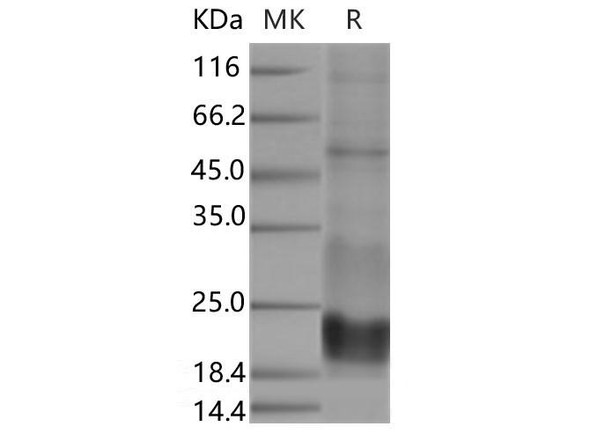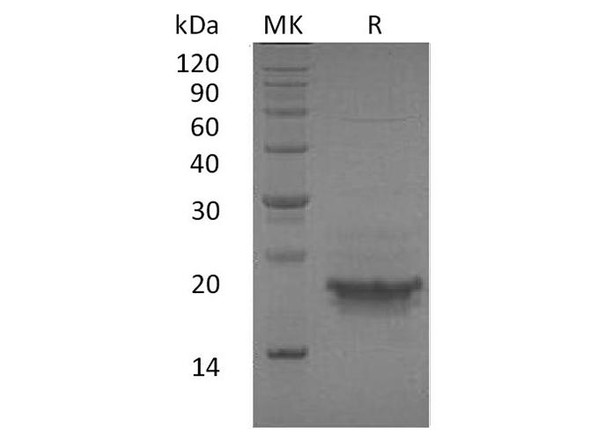Description
| Product Name: | Human CD3e Recombinant Protein |
| Product Code: | RPPB3071 |
| Size: | 10µg |
| Species: | Human |
| Target: | CD3e |
| Synonyms: | T-cell surface glycoprotein CD3 epsilon chain, T-cell surface antigen T3/Leu-4 epsilon chain, CD3e, T3E, TCRE. |
| Source: | Escherichia Coli |
| Physical Appearance: | Sterile Filtered colorless solution. |
| Formulation: | The CD3e solution (1mg/ml) contains 20mM Tris-HCl buffer (pH 8.0), 0.2M NaCl and 10% glycerol. |
| Stability: | Store at 4°C if entire vial will be used within 2-4 weeks. Store, frozen at -20°C for longer periods of time. For long term storage it is recommended to add a carrier protein (0.1% HSA or BSA).Avoid multiple freeze-thaw cycles. |
| Purity: | Greater than 90% as determined by SDS-PAGE. |
| Amino Acid Sequence: | MGSSHHHHHH SSGLVPRGSH MGSDGNEEMG GITQTPYKVS ISGTTVILTC PQYPGSEILW QHNDKNIGGD EDDKNIGSDE DHLSLKEFSE LEQSGYYVCY PRGSKPEDAN FYLYLRARVC ENCMEMD |
CD3-epsilonpolypeptide (CD3E) along with CD3-gamma, -delta and -zeta, and the T-cell receptor alpha/beta and gamma/delta heterodimers, creates the T-cell receptor-CD3 complex. This complex has an imperative role in coupling antigen recognition to a number of intracellular signal-transduction pathways. The genes encoding the epsilon, gamma delta polypeptides are found in the same cluster on chromosome 11. The epsilon polypeptide plays a vital role in T-cell development. CD3E gene defects cause immunodeficiency. CD3E is also linked to a susceptibility to type I diabetes in women.
CD3e Human Recombinant produced in E. coli is a single polypeptide chain containing 127 amino acids (23-126) and having a molecular mass of 14.1kDa.CD3e is fused to a 23 amino acid His-tag at N-terminus & purified by proprietary chromatographic techniques.
| UniProt Protein Function: | CD3E: a T cell surface glycoprotein that is a component of the T cell antigen receptor. The recruitment of Nck by CD3 epsilon reveals a ligand-induced conformational change essential for T cell receptor signaling and synapse formation. Contains 1 immunoglobulin-like domain and 1 ITAM domain. |
| UniProt Protein Details: | Protein type:Receptor, misc.; Membrane protein, integral Chromosomal Location of Human Ortholog: 11q23 Cellular Component: T cell receptor complex; integral to plasma membrane; plasma membrane; immunological synapse; alpha-beta T cell receptor complex; intercellular junction; external side of plasma membrane Molecular Function:protein binding; transmembrane receptor activity; receptor signaling complex scaffold activity; protein heterodimerization activity; receptor signaling protein activity; T cell receptor binding; SH3 domain binding; protein kinase binding Biological Process: regulation of immune response; T cell activation; positive regulation of interleukin-2 biosynthetic process; signal complex assembly; positive regulation of calcium-mediated signaling; negative thymic T cell selection; T cell receptor signaling pathway; positive regulation of interleukin-4 production; regulation of apoptosis; G-protein coupled receptor protein signaling pathway; positive regulation of interferon-gamma production; positive regulation of peptidyl-tyrosine phosphorylation; cell surface receptor linked signal transduction; negative regulation of smoothened signaling pathway; T cell costimulation; protein complex assembly; positive regulation of alpha-beta T cell proliferation; positive regulation of T cell proliferation; positive regulation of T cell anergy; transmembrane receptor protein tyrosine kinase signaling pathway; response to nutrient Disease: Immunodeficiency 18 |
| NCBI Summary: | The protein encoded by this gene is the CD3-epsilon polypeptide, which together with CD3-gamma, -delta and -zeta, and the T-cell receptor alpha/beta and gamma/delta heterodimers, forms the T-cell receptor-CD3 complex. This complex plays an important role in coupling antigen recognition to several intracellular signal-transduction pathways. The genes encoding the epsilon, gamma and delta polypeptides are located in the same cluster on chromosome 11. The epsilon polypeptide plays an essential role in T-cell development. Defects in this gene cause immunodeficiency. This gene has also been linked to a susceptibility to type I diabetes in women. [provided by RefSeq, Jul 2008] |
| UniProt Code: | P07766 |
| NCBI GenInfo Identifier: | 1345708 |
| NCBI Gene ID: | 916 |
| NCBI Accession: | P07766.2 |
| UniProt Related Accession: | P07766 |
| Molecular Weight: | |
| NCBI Full Name: | T-cell surface glycoprotein CD3 epsilon chain |
| NCBI Synonym Full Names: | CD3e molecule |
| NCBI Official Symbol: | CD3E�� |
| NCBI Official Synonym Symbols: | T3E; TCRE; IMD18�� |
| NCBI Protein Information: | T-cell surface glycoprotein CD3 epsilon chain |
| UniProt Protein Name: | T-cell surface glycoprotein CD3 epsilon chain |
| UniProt Synonym Protein Names: | T-cell surface antigen T3/Leu-4 epsilon chain; CD_antigen: CD3e |
| UniProt Gene Name: | CD3E�� |
| UniProt Entry Name: | CD3E_HUMAN |










